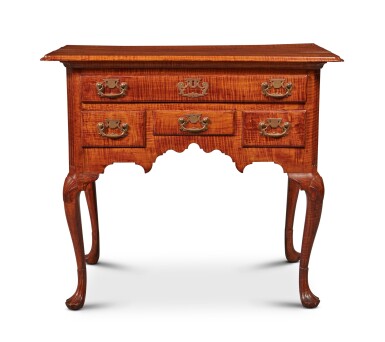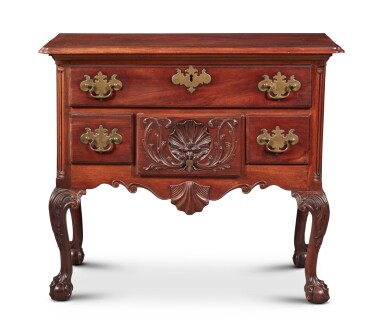Exceptional Carved and Figured Maple, Engraved Brass, Silver Inlaid, and Steel Flintlock American Long RifleAttributed to Jacob Kuntz (1780–1876) or John Rupp the Younger (1762-1836)Lehigh Valley area, PennsylvaniaCirca 1808-12 With engraved silver Northampton School 'Indian Head'. Appears to retain its original flintlock, .52 caliber smoothbore.Length 57 7/8 in.; Barrel Length 42 in.ProvenanceDon Newcomer, Pennsylvania; Tom Wilson Ohio James R. Johnston, Ashley, Ohio; John Kolar, Mt. Gretna, Pennsylvania.LiteratureJames R. Johnston Accoutrements: Kentucky Rifles and Pistols, Tomahawks, Axes, Knives, Powder Horns, Hunting Bags and Accoutrements from 1750-1850, (Delaware, OH: Golden Age Arms Co., 1990), pp. 21-22.Catalogue noteIn juxtaposition to the Pre-Revolutionary War long rifle by the elder John George Rupp, lot 498, this rifle exemplifies the rapid evolution of form that the American rifle underwent in the Lehigh Valley area alone over the course of forty years. The architecture becomes increasingly slender with an accentuated roman-nose and carving that has greatly advanced to include a highly refined combination of checkering and low relief angled cuts that comprise the floral cartouche on the butt stock and V-shaped wrist. The Northampton Indian head on this rifle is in the same spot as the Rupp, forward of the trigger guard, but is in the form of engraved silver inlay piece rather than incised. Other silver inlays include expertly engraved silver spread-winged eagle above the cheek piece and flowers in the center of the cartouche on a field of meticulous checkering. The heightened level of control and proficiency that the gunsmith had in the carving and engraving cannot be overly praised on this Golden Age rifle. The beautiful curly maple stock is furthermore enhanced with a violin finish, making this rifle an emblem of extraordinary refinement exalted in the Federal period. One of the most enjoyable aspects of this rifle is trying to solve the enigma of identifying its maker, even if the effort ultimately futile. The gunsmiths Jacob Kuntz (1780–1876) and to John Rupp the Younger (1762-1836), son of Andrew Rupp, share a vast majority of identical gunsmithing techniques and stylistic qualities that it can be impossible to differentiate between these two contemporaneous makers. And there are boundless reasons as to why their guns are so similar: the two likely lived in walking distance and knew each other’s work, they could have worked together, they could have swapped or shared apprentices etc. American long rifle scholar, Ronald Gabel, acknowledges these complexities in his in-depth study of the Northampton region of gunsmithing, but manages to note some differentiating qualities. Both gunsmiths employed the oval floral and checkered carved cartouche previously described. Nevertheless, Rupp was apt to include a carved flower on the side wall of the cartouche, just rear of the cheek piece, whereas Kuntz rifles, many of which are signed, do not appear to include this flower. A highly similar example of a rifle signed by John Rupp the younger is featured in Gabel’s article, “The Northampton County, Pennsylvania, School of Gunsmithing.” This signed Rupp rifle features a Kuntz-style four-piece patchbox, typical Rupp forend inlays, and the additional flower in the cartouche, all of which are present on the subject rifle. Nevertheless, in arguing that the rifle has additional Kuntz features, the architecture near the trigger guard bow of this signed Rupp example in Gabel’s article contains a step in the bottom contour of the stock; a feature that is not employed by Kuntz and not apparent on the subject gun. Furthermore, every signed Rupp rifle contains a two-piece side plate that is virtually identical to the one Gabel pictures. Kuntz rifles, as well as the one in question, have a single side plate. There are some decorative and/or architectural designs employed by Rupp while others are employed by Kuntz, but it is general
Exceptional Carved and Figured Maple, Engraved Brass, Silver Inlaid, and Steel Flintlock American Long RifleAttributed to Jacob Kuntz (1780–1876) or John Rupp the Younger (1762-1836)Lehigh Valley area, PennsylvaniaCirca 1808-12 With engraved silver Northampton School 'Indian Head'. Appears to retain its original flintlock, .52 caliber smoothbore.Length 57 7/8 in.; Barrel Length 42 in.ProvenanceDon Newcomer, Pennsylvania; Tom Wilson Ohio James R. Johnston, Ashley, Ohio; John Kolar, Mt. Gretna, Pennsylvania.LiteratureJames R. Johnston Accoutrements: Kentucky Rifles and Pistols, Tomahawks, Axes, Knives, Powder Horns, Hunting Bags and Accoutrements from 1750-1850, (Delaware, OH: Golden Age Arms Co., 1990), pp. 21-22.Catalogue noteIn juxtaposition to the Pre-Revolutionary War long rifle by the elder John George Rupp, lot 498, this rifle exemplifies the rapid evolution of form that the American rifle underwent in the Lehigh Valley area alone over the course of forty years. The architecture becomes increasingly slender with an accentuated roman-nose and carving that has greatly advanced to include a highly refined combination of checkering and low relief angled cuts that comprise the floral cartouche on the butt stock and V-shaped wrist. The Northampton Indian head on this rifle is in the same spot as the Rupp, forward of the trigger guard, but is in the form of engraved silver inlay piece rather than incised. Other silver inlays include expertly engraved silver spread-winged eagle above the cheek piece and flowers in the center of the cartouche on a field of meticulous checkering. The heightened level of control and proficiency that the gunsmith had in the carving and engraving cannot be overly praised on this Golden Age rifle. The beautiful curly maple stock is furthermore enhanced with a violin finish, making this rifle an emblem of extraordinary refinement exalted in the Federal period. One of the most enjoyable aspects of this rifle is trying to solve the enigma of identifying its maker, even if the effort ultimately futile. The gunsmiths Jacob Kuntz (1780–1876) and to John Rupp the Younger (1762-1836), son of Andrew Rupp, share a vast majority of identical gunsmithing techniques and stylistic qualities that it can be impossible to differentiate between these two contemporaneous makers. And there are boundless reasons as to why their guns are so similar: the two likely lived in walking distance and knew each other’s work, they could have worked together, they could have swapped or shared apprentices etc. American long rifle scholar, Ronald Gabel, acknowledges these complexities in his in-depth study of the Northampton region of gunsmithing, but manages to note some differentiating qualities. Both gunsmiths employed the oval floral and checkered carved cartouche previously described. Nevertheless, Rupp was apt to include a carved flower on the side wall of the cartouche, just rear of the cheek piece, whereas Kuntz rifles, many of which are signed, do not appear to include this flower. A highly similar example of a rifle signed by John Rupp the younger is featured in Gabel’s article, “The Northampton County, Pennsylvania, School of Gunsmithing.” This signed Rupp rifle features a Kuntz-style four-piece patchbox, typical Rupp forend inlays, and the additional flower in the cartouche, all of which are present on the subject rifle. Nevertheless, in arguing that the rifle has additional Kuntz features, the architecture near the trigger guard bow of this signed Rupp example in Gabel’s article contains a step in the bottom contour of the stock; a feature that is not employed by Kuntz and not apparent on the subject gun. Furthermore, every signed Rupp rifle contains a two-piece side plate that is virtually identical to the one Gabel pictures. Kuntz rifles, as well as the one in question, have a single side plate. There are some decorative and/or architectural designs employed by Rupp while others are employed by Kuntz, but it is general













Testen Sie LotSearch und seine Premium-Features 7 Tage - ohne Kosten!
Lassen Sie sich automatisch über neue Objekte in kommenden Auktionen benachrichtigen.
Suchauftrag anlegen